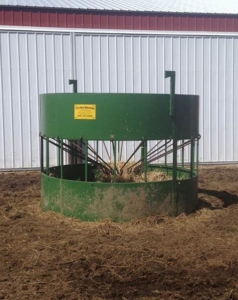Horse owners and experts tout the benefits of round bale feeders
One of the biggest expenses horse owners face is the cost of feed. Fluctuations in the hay market can significantly impact the cost of feeding your horses. Therefore anything you can do to keep the costs of such feed down can positively impact your bottom line.

Round bales are in most cases a cheaper alternative to small square bales since they require less labor and baling time to produce. Experts will tell you that the best way to feed round bales to horses is a feeder. That’s because a feeder will drastically reduce hay waste by preventing spoilage when hay gets on the ground and is trampled or contaminated with horse or other animal waste. Since horses can be picky eaters, a round bale feeder will ensure that your horses stay healthy and well-fed because their hay feed remains as fresh as possible.
Round bale feeders in particular have been found to be most effective in preventing hay waste. And while such feeders may be more expensive than other types of feeders, in the long run they can save farmers and ranchers a significant amount of money. In fact, experts say that most round bale feeders will pay for themselves in less than two years – and in some cases even sooner.
There are many options when it comes to round bale feeders. Here are some important things to keep in mind when choosing one for your horses:
1. Round bale feeders need to be well-designed and solidly constructed. Many commercial round bale hay feeders are made of cheap materials that are unable to stand up over time and are prone to rust.
2. Feeders should always sit up off of the ground so that horses will eat the hay at the bottom first. This keeps most of the hay inside the actual bale because horses will be less likely to reach up to pull hay off the top of the bale, spilling hay on the ground where it will spoil.
3. Remember that all round bale feeders are not created equal. While many companies sell “one size fits all’ hay feeders, different animals have different requirements. For instance, horse feeders need to have a two feet bottom band, a one foot top band, and openings that are spaced approximately 15 inches apart.
Experts will tell you over and over that for health and economic reasons, nothing beats feeding horses round bales of hay. These same experts also will tell you that for all of the benefits of round bale feeding, if you don’t purchase a round bale feeder, most of those benefits will be lost.

